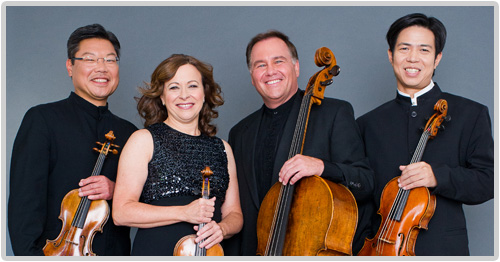by Daniel Hathaway

The Miami — violinists Benny Kim and Cathy Meng Robinson, violist Scott Lee, and cellist Keith Robinson — bookended their program with standard works in the key of E-flat. Haydn’s No. 30 and Dvořák’s No. 10 share a general feeling of Gemütlichkeit, although each offers its own surprises.
Coming just past the midpoint of Haydn’s total of 68 quartets, No. 30 is nicknamed “The Joke” for its amusing faux endings and beginnings in the fourth movement Scherzo. Its opening Allegro features some sudden bravura gestures from the first violin, and a Scherzo that acts more like a minuet. At first, the Miami took a few moments to settle into a reliable intonation groove, but by the time the jokes appeared, everything was in good working order, and audible chuckles confirmed that Haydn’s touches of humor had been put across.
Dvořák’s piece comes two-thirds of the way through his 15 quartets, and was written to order as a Slavonic work for the Florentine Quartet. Those ethnic touches come mainly in the second movement dumka and the finale, which suggests a traditional Czech skona.
Otherwise, the work is typically cheerful — the composer can’t stay elegiac forever — and sometimes ebullient. The third movement Romanza is tender and expressive, and Dvořák’s habit of taking sudden plunges into other keys without really modulating gives the fourth movement extra sophistication and harmonic interest.
The middle work finds Erwin Schulhoff taking inspiration from all the —isms of the 1920s. Complex and busy, the first movement suddenly morphs into a cello ostinato, while the second movement theme and variations format just as suddenly abandons its dense counterpoint and turns the corner into a dance hall. Hearty unisons and strong, rhythmic themes characterize the finale. The Miami took up each stylistic change instantly and delivered a gripping performance.
The Miami Quartet made a strong contribution to the faculty series in this unusual summer. The live feed was well-managed, the audio was rich and clear, and the applause thunderous. Welcome back, audience folk. You were missed.
Published on ClevelandClassical.com July 27, 2021.
Click here for a printable copy of this article



